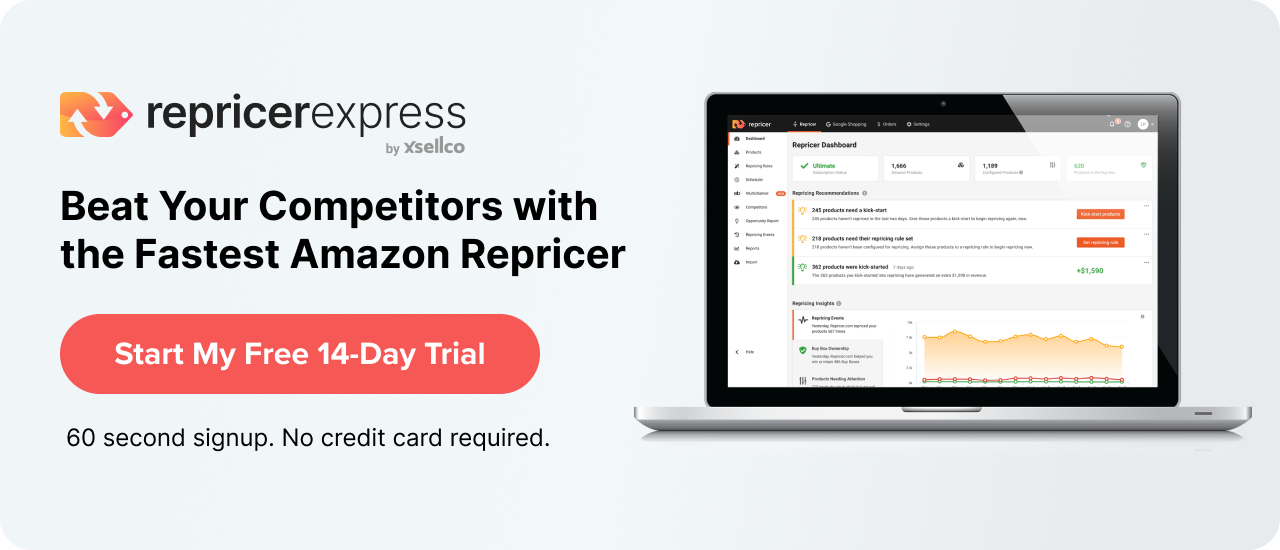Amazon is a hugely crowded marketplace, which means you need to use every trick in the book to stay ahead of your competitors. There are many ways of doing that, but one of the best short- and long-term strategies is to focus on your branding.
RepriceExpress has five rules you can start using right now to leapfrog other sellers.
Breaking Down Branding on Amazon
In a nutshell, branding is the meaning a user forms in their mind about a product or company. If someone says to use “Beats by Dre” or “Apple”, what are the first words that come to your mind?
Spoiler: That was a bit of a trick question, as there are plenty of words that immediately come to mind and that’s the result of successful branding. When you think of companies like beats and Apple, you have a very definite idea of what they are and what they produce.
Going even further, there’s good branding and bad branding. Good branding is when a product or company elicits quality, consistency, recognizable name and image, and a desire to buy from them. Companies like Sennheiser, Lexus, Marmot and Patagonia are known for very specific qualities within their product lines, while also delivering high-quality, long-lasting items. They’ve developed reputations that make people choose them over many others, no matter how crowded the market.
At the opposite end are companies with bad branding. They do things like overpromise and underdeliver, hype themselves too much, launch too many products instead of focusing on building quality pieces, attack other brands, blending in with the crowd, being inconsistent, and failing to keep up with wants and trends. And because people share bad experiences far more than positive ones, you don’t have to look too far to find examples of bad branding.
When it comes to being successful at branding on Amazon, there are several rules you should learn and internalize.
Rule 1: What’s in a Name?
Shakespeare wrote that “a rose by any other name would smell as sweet”, but that’s only true in love, and not ecommerce. Names matter, and they matter a lot. Everything you do in the future will come down to your name, so it’s important to get it right.
One common mistake to avoid is putting the product name in the brand. You might think you’ll never have another product or you’re too small to expand, but you might in the future and your product-name-name-in-the-brand-name will really limit you. Imagine expanding your inventory in the future and selling different items under the same name — buyers will be confused and look elsewhere.
Another thing to avoid is personal names. It can work in some cases (e.g. David’s Tea, Ferrari, JCPenney, etc.), especially if it’s clothing-geared, but it’s a better idea to think of something catchy, unique, strong and easy to spell/remember.
Once you’ve got a name, do a final check online to make sure nobody else has it, then claim it for yourself.
Rule 2: Design a Logo
The next step is to get a logo going, an image that will immediately make people think of your brand name (and vice versa).
Getting a solid logo in place is important, but not as much as the brand name itself. That’s because you can — and probably will — change it over time. Just look at how logos by Google, Visa, Apple, Toyota, Levis and more have changed throughout the years.
But just because the logo isn’t as crucial as the brand name doesn’t mean you should skimp in this area. If anything, it deserves a set of expert eyes to get it roaring out of the gate. If you have a background in marketing, user testing and graphic design, go ahead and design it yourself. Otherwise, hand over the reins to a pro to get the job done.
Related: 7 Ways to Create a Logo for Your Ecommerce Store
Rule 3: Trademark Your Brand
With great brand power comes great responsibility, and one of the smartest things you can do is trademark your efforts. It’s not a foolproof step to locking out impostors and hijackers, but it goes a long way in protecting you.
Another way of protecting yourself is to build a website. You don’t have to get super fancy or reinvent the wheel, simply pop up a website using a website builder and Bob’s your uncle. How this helps is if you need to prove you’re the rightful owner of your brand, and you can use your website as a paper trail.
Having a (trademarked) brand name and logo in place are requirements for enrolling in Amazon’s Brand Registry, so sign up there once you’ve got both of these.
Rule 4: Enhance Your Brand Content
You don’t have to do this, but using Enhance Brand Content vs. a regular listing is like the difference between a tricycle and a fighter jet: the former will technically get you from Point A to Point B, but the latter is faster, flashier and gets a lot more attention.
EBC pages allow you to upload more images and better (and more detailed) descriptions, giving you extra space to really sell your product. If Joe Blow can list 10 features about his gizmo but you can only list 3 about the same, who do you think buyers are going to trust more?
Rule 5: Constant Vigilance!
You might have tilled the soil and planted a good selection of crops, but they’re not going to water and fertilize themselves.
When it comes to your brand, give it regular attention so it flowers to its utmost potential. You’ll need to work hard at getting people to become deeply acquainted with your brand, but luckily, there are time-tested ways of going about this.
Blog on your website. Not only does it give consumers regular and new information about your products, building knowledge and trust, but it also helps you rank better in Google because they’re seeing novel and relevant contenting coming from you.
You should also be using social media channels to interact with users, whether that’s with poignant conversations or strategic advertising. When it comes to advertising specifically, make sure to re-research keywords several times a year to ensure you’ve got the best-ranking and competitive ones, then cross-reference them with your listings, updating as necessary.
Lastly, listen to what people are saying. If they’re taking the time out of their day to give you their opinion, you’re getting valuable (and free!) advice that you should be applying. Positive feedback tells you to stay on the right track, while negative feedback is an indication of what you need to fix. And while you can’t delete negative reviews, there are steps you can take to remedy bad feedback.
Final Thoughts
As important as branding on Amazon is, you also can’t forget about having competitive pricing. Buyers might instantly connect your brand in positive and memorable ways, but they won’t buy from you if you don’t offer a good deal. Luckily, RepricerExpress is there to make sure that never happens to you, helping you combine timing with pricing in ways your competitors might have neglected. To enjoy that loftier perch, sign up now and kickstart your free trial.



